Vertical Cavity Surface Emitting Laser Performance Maturing through Machine Learning for High-Yield Optical Wireless Network
Abstract
1. Introduction
1.1. Prior Work
1.2. Motivation
1.3. Main Contribution
- High-brightness and high-speed VCSEL are evaluated using the ML algorithm, to purify the optical beam and enable the OWN to handle high-speed data transmission.
- The transmitter side’s digital signal processing (DSP) block is designed for OWN using the advanced quadrature amplitude modulation-orthogonal frequency division multiplexing (QAM-OFDM) scheme. This technique has strengthened the OWN outputs against novel impairments such as nonlinearities.
- Various new procedures are applied, examining OWN and presenting ML-based VCSEL efficiencies such as data rate, spectral efficiency (SE), power levels, fiber path cover, and different visualizers.
- The ML mode is evaluated for the presented VCSEL, and a detailed analytical model is discussed and matched with the simulation estimations.
- The simulation results are measured and compared to the achievements of the proposed ML-based VCSEL and OWN with conventional laser sources.
2. VCSEL-Based OWN System Model
3. Results Analysis
3.1. Spectral Efficiency Analysis
3.2. Received Power Analysis for ML-Based VCSEL
3.3. Measuring Result Analysis Using Data Rate and Optical Spectrum Visualizer
3.4. VCSEL-Based OWN Analysis Using Fiber Length and Channel Spacing
3.5. Polarization, VCSEL Spectrum, and Constellation Visualizer Analysis
4. Conclusions
Author Contributions
Funding
Institutional Review Board Statement
Informed Consent Statement
Data Availability Statement
Conflicts of Interest
References
- Ali, F.; Ahmad, S.; Muhammad, F.; Abbas, Z.H.; Habib, U.; Kim, S. Adaptive Equalization for Dispersion Mitigation in Multi-Channel Optical Communication Networks. Electronics 2019, 8, 1364. [Google Scholar] [CrossRef]
- Kazemi, H.; Sarbazi, E.; Soltani, M.D.; Safari, M.; Haas, H. A Tb/s indoor optical wireless backhaul system using VCSEL arrays. In Proceedings of the 2020 IEEE 31st Annual International Symposium on Personal, Indoor and Mobile Radio Communications, London, UK, 31 August–3 September 2020; pp. 1–6. [Google Scholar]
- Haghighi, N.; Moser, P.; Lott, J.A. Power, bandwidth, and efficiency of single VCSELs and small VCSEL arrays. IEEE J. Sel. Top. Quantum Electron. 2019, 25, 1–15. [Google Scholar] [CrossRef]
- Khan, Z.; Shih, J.-C.; Chao, R.-L.; Tsai, T.-L.; Wang, H.-C.; Fan, G.-W.; Lin, Y.-C.; Shi, J.-W. High-brightness and high-speed verticalcavity surface-emitting laser arrays. Optica 2020, 7, 267–275. [Google Scholar] [CrossRef]
- Ledentsov, N.N.; Shchukin, V.A.; Kalosha, V.P.; Ledentsov, N.N., Jr.; Kropp, J.-R.; Augustin, M.; Chorchos, Ł.; Turkiewicz, J.P.; Shi, J.-W. Anti–waveguiding vertical–cavity surface–emitting laser at 850 nm: From concept to advances in high–speed data transmission. Opt. Exp. 2018, 26, 445–453. [Google Scholar] [CrossRef]
- Haghighi, N.; Moser, P.; Zorn, M.; Lott, J.A. 19-element vertical cavity surface emitting laser arrays with inter-vertical cavity surface emitting laser ridge connectors. J. Phys. Photon. 2020, 2, 04LT01. [Google Scholar] [CrossRef]
- Shih, J.-C.; Khan, Z.; Chang, Y.-H.; Shi, J.-W. High-brightness VCSEL arrays with inter-mesa waveguides for the enhancement of efficiency and high-speed data transmission. IEEE J. Sel. Top. Quantum Electron. 2022, 28, 1–11. [Google Scholar] [CrossRef]
- Cheng, C.-L.; Ledentsov, N.; Khan, Z.; Yen, J.-L.; Ledentsov, N.N.; Shi, J.-W. Ultrafast Zn-diffusion and oxide-relief 940 nm vertical-cavity surface-emitting lasers under high-temperature operation. IEEE J. Sel. Top. Quantum Electron. 2019, 25, 1–7. [Google Scholar] [CrossRef]
- Khan, Z.; Chang, Y.H.; Pan, T.L.; Zhao, Y.C.; Huang, Y.Y.; Lee, C.H.; Shi, J.W. High-Brightness, High-Speed, and Low-Noise VCSEL Arrays for Optical Wireless Communication. IEEE Access 2022, 10, 2303–2317. [Google Scholar] [CrossRef]
- Zhao, Y.; Ahmad, Z.; Long, W.; Khan, Z.; Ledentsov, N.; Sanayeh, M.B.; Pan, T.; Chen, C.; Chang, C.; Lu, T.; et al. Separated electrodes for the enhancement of high-speed data transmission in vertical-cavity surface-emitting laser arrays. Opt. Express 2022, 30, 26690–26700. [Google Scholar] [CrossRef] [PubMed]
- Chen, Z.; Sludds, A.; Davis, R.; Christen, I.; Ateshian, L.; Bernstein, L.; Englund, D. Coherent VCSEL Network Computing. In Proceedings of the 2022 27th OptoElectronics and Communications Conference (OECC) and 2022 International Conference on Photonics in Switching and Computing (PSC), Toyama, Japan, 3–6 July 2022; pp. 1–3. [Google Scholar] [CrossRef]
- Ncube, W.Z.; Qidan, A.A.; El-Gorashi, T.; Elmirghani, M.H.J. On the energy efficiency of Laser-based Optical Wireless Networks. In Proceedings of the 2022 IEEE 8th International Conference on Network Softwarization (NetSoft), Milan, Italy, 27 June–1 July 2022; pp. 7–12. [Google Scholar] [CrossRef]
- Elgamal, A.S.; Aletri, O.Z.; Qidan, A.A.; El-Gorashi, T.E.H.; Elmirghani, J.M.H. Reinforcement Learning for Resource Allocation in Steerable Laser-Based Optical Wireless Systems. In Proceedings of the 2021 IEEE Canadian Conference on Electrical and Computer Engineering (CCECE), Ottawa, ON, Canada, 12–17 September 2021; pp. 1–6. [Google Scholar] [CrossRef]
- Chen, Z.; Sludds, A.; Davis, R.; Bernstein, L.; Ateshian, L.; Christen, I.; Heuser, T.; Lott, J.; Reitzenstein, S.; Englund, D.; et al. Coherent optical neural network with injection-locked VCSELs. In Proceedings of the Conference on Lasers and Electro-Optics, Technical Digest Series (Optica Publishing Group, 2022), Paper STh5G.4, San Jose, CA, USA, 15–20 May 2022. [Google Scholar]
- Strzebonski, P.; Dave, H.; Lakomy, K.; Jahan, N.; North, W.; Choquette, K. Computational methods for VCSEL array characterization and control. In Proceedings of the SPIE 11704, Vertical-Cavity Surface-Emitting Lasers XXV, 117040L, Online, 5 March 2021. [Google Scholar]
- Rahman, S.; Ali, F.; Smagor, A.; Muhammad, F.; Habib, U.; Glowacz, A.; Ahmad, S.; Irfan, M.; Smalcerz, A.; Kula, A.; et al. Mitigation of Nonlinear Distortions for a 100 Gb/s Radio-Over-Fiber-Based WDM Network. Electronics 2020, 9, 1796. [Google Scholar] [CrossRef]
- Jalal, S.K.; Al-Maqdici, R.Z.Y. Enhanced Performance of 32 GHz up to 200 km Vertical Cavity Surface Emitting Laser (VCSEL) for FrontHaul Radio Over Fiber System. Arab. J. Sci. Eng. 2022. [Google Scholar] [CrossRef]
- Singh, C.K.; Bhatia, R.; Raghuvanshi, A. Generation and transmission of 60-GHz mmWave emitted by VCSEL, DFB–EAM over RoF. Int. J. Inf. Technol. 2021, 13, 83–87. [Google Scholar] [CrossRef]
- Chaqmaqchee, F.A.I.; Lott, J.A. Impact of oxide aperture diameter on optical output power, spectral emission, and bandwidth for 980 nm VCSELs. OSA Contin. 2020, 3, 2602–2613. [Google Scholar] [CrossRef]
- Mao, K.; Zhu, Q.; Song, M.; Ning, B.; Hua, B.; Zhong, W.; Chen, X. A Novel Non-stationary Channel Model for UAV-to-Vehicle mmWave Beam Communications. Mach. Learn. Intell. Commun. 2021, 471–484. [Google Scholar] [CrossRef]
- Muhammad, F.; Ali, F.; Habib, U.; Usman, M.; Khan, I.; Kim, S. Time domain equalization and digital back-propagation method-based receiver for fiber optic communication systems. Int. J. Opt. 2020, 2020, 3146374. [Google Scholar] [CrossRef]
- Ali, F.; Muhammad, F.; Habib, U.; Khan, Y.; Usman, M. Modeling and minimization of FWM effects in DWDM-based long-haul optical communication systems. Photon. Netw. Commun. 2020, 51, 36–46. [Google Scholar] [CrossRef]
- Karembera, R.; Censur, C.; Gibbon, T. Sub-60-GHz powerefficient fronthaul system of up to 16-Gbps using RF carriers generated from a gain-switched VCSEL. OSA Contin. 2020, 3, 3482–3496. [Google Scholar] [CrossRef]
- Muñoz, C.D.; Varón, M.; Destic, F.; Rissons, A. Phase noise modeling and characterization of a self-started VCSEL-based harmonic frequency generator (SVHFG). Opt. Laser Technol. 2021, 143, 107176. [Google Scholar] [CrossRef]
- Muñoz, C.D.; Rissons, A.; Destic, F.; Rico, J.C.; Varón, M. VCSEL-based optoelectronic oscillator (VBO) for 1.25 Gbit/s RZ pulse optical data generation. In Proceedings of the 2018 International Topical Meeting on Microwave Photonics (MWP), IEEE, Toulouse, France, 22–25 October 2018. [Google Scholar]
- Dar, A.B.; Ahmad, F. A full-duplex 40 GHz radio-over-fiber transmission system based on frequency octupling. Opt. Quantum Electron. 2019, 51, 324. [Google Scholar] [CrossRef]
- Zhang, L.; Wei, Z.; Wang, Z.; Geng, Z.; Wei, G.; Cheng, J.; Fu, H.-Y.; Dong, Y. High-speed multi-user optical wireless communication between VCSEL-integrated electronic devices. Opt. Commun. 2021, 486, 126774. [Google Scholar] [CrossRef]
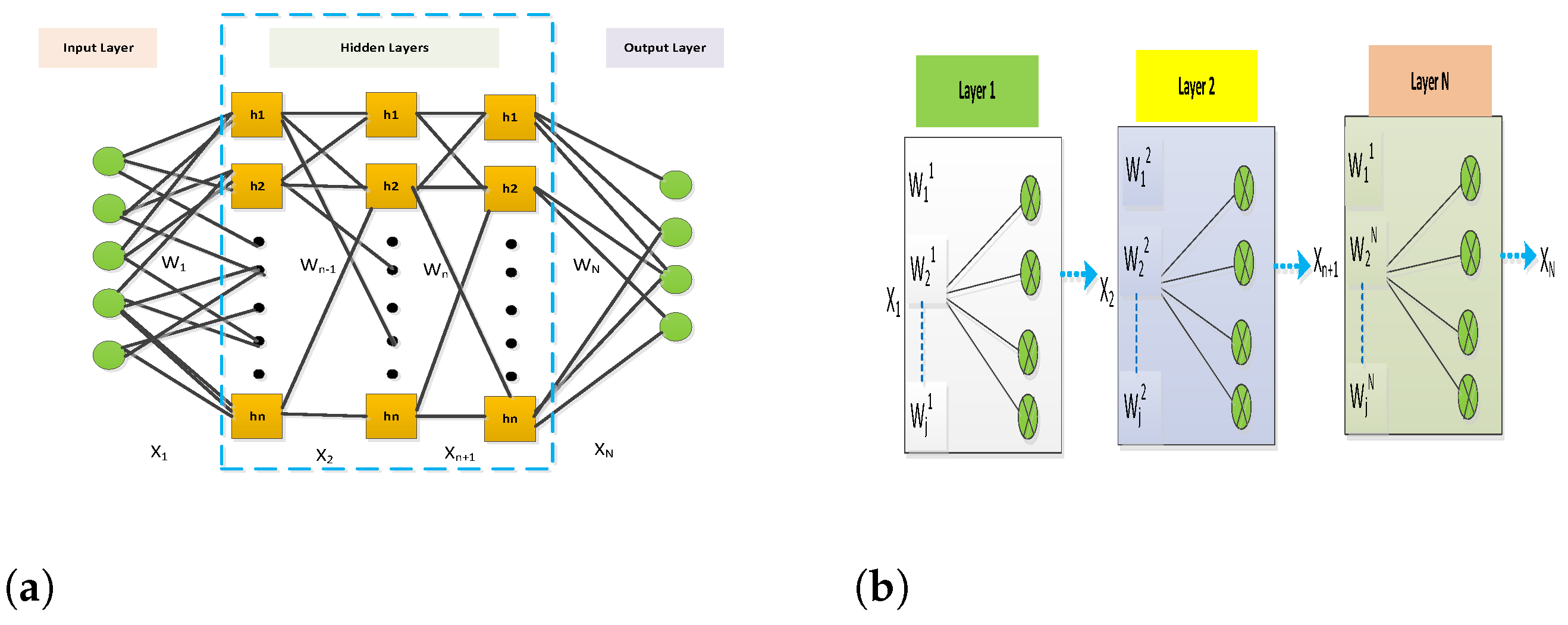
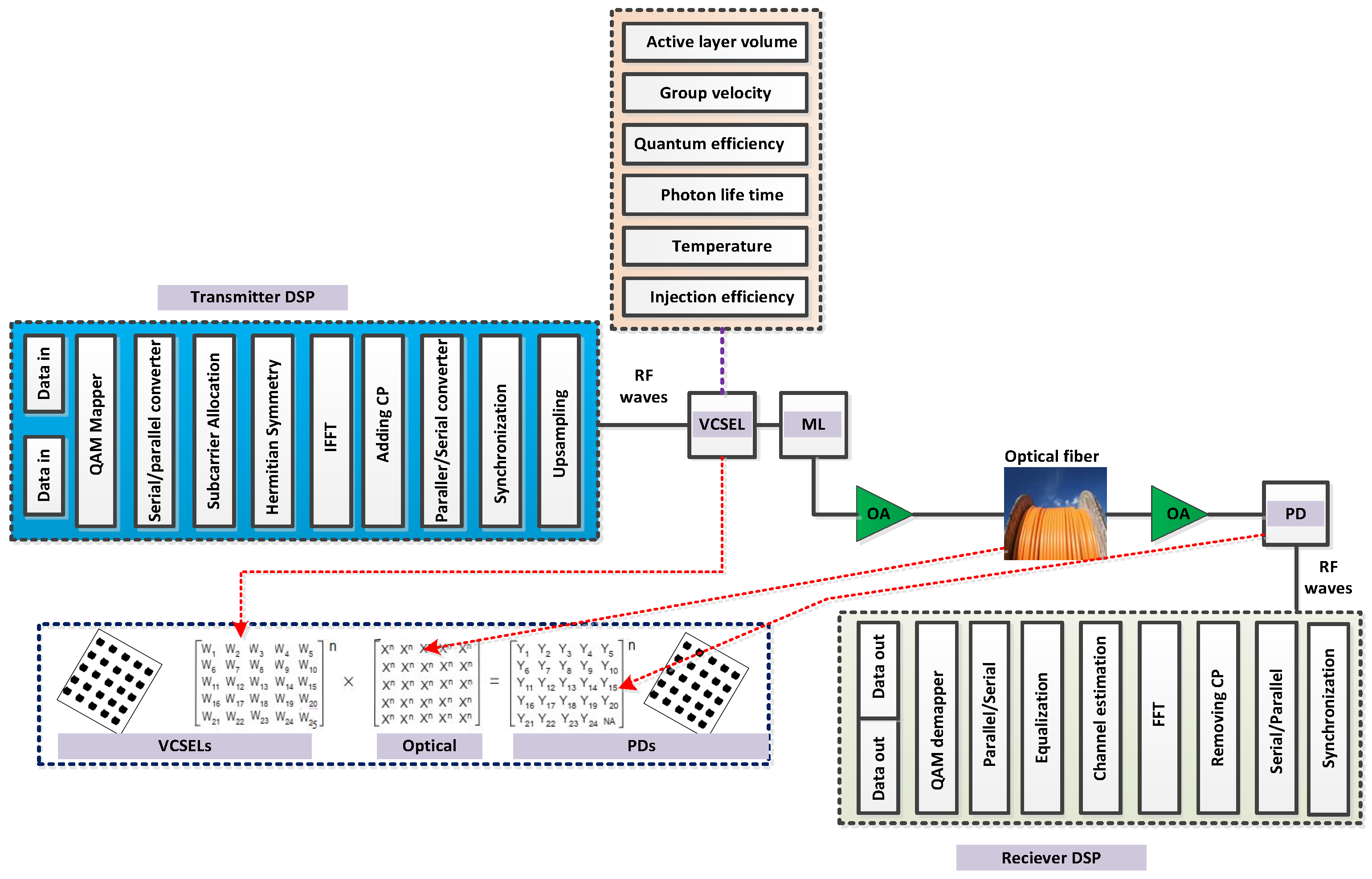
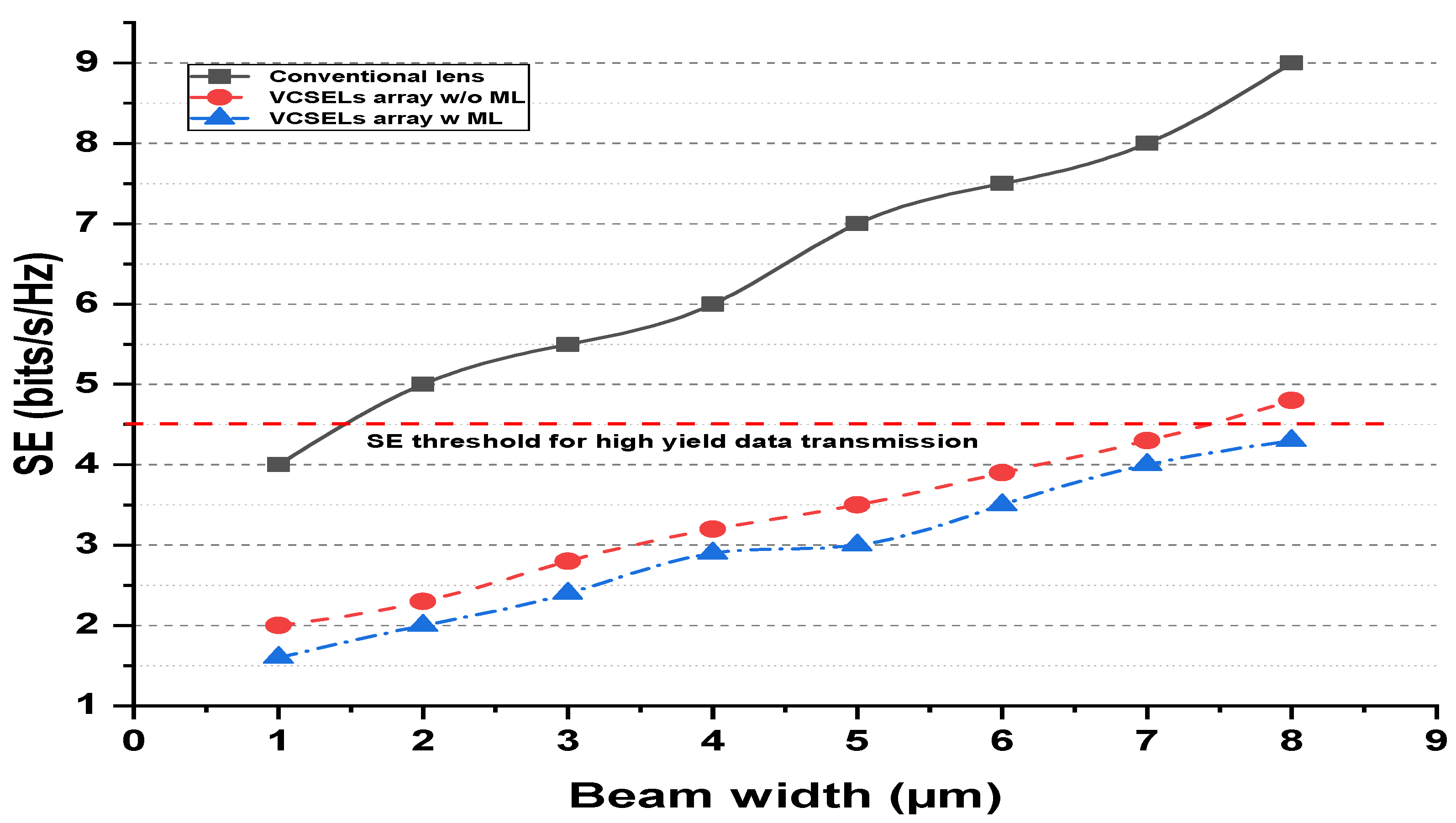
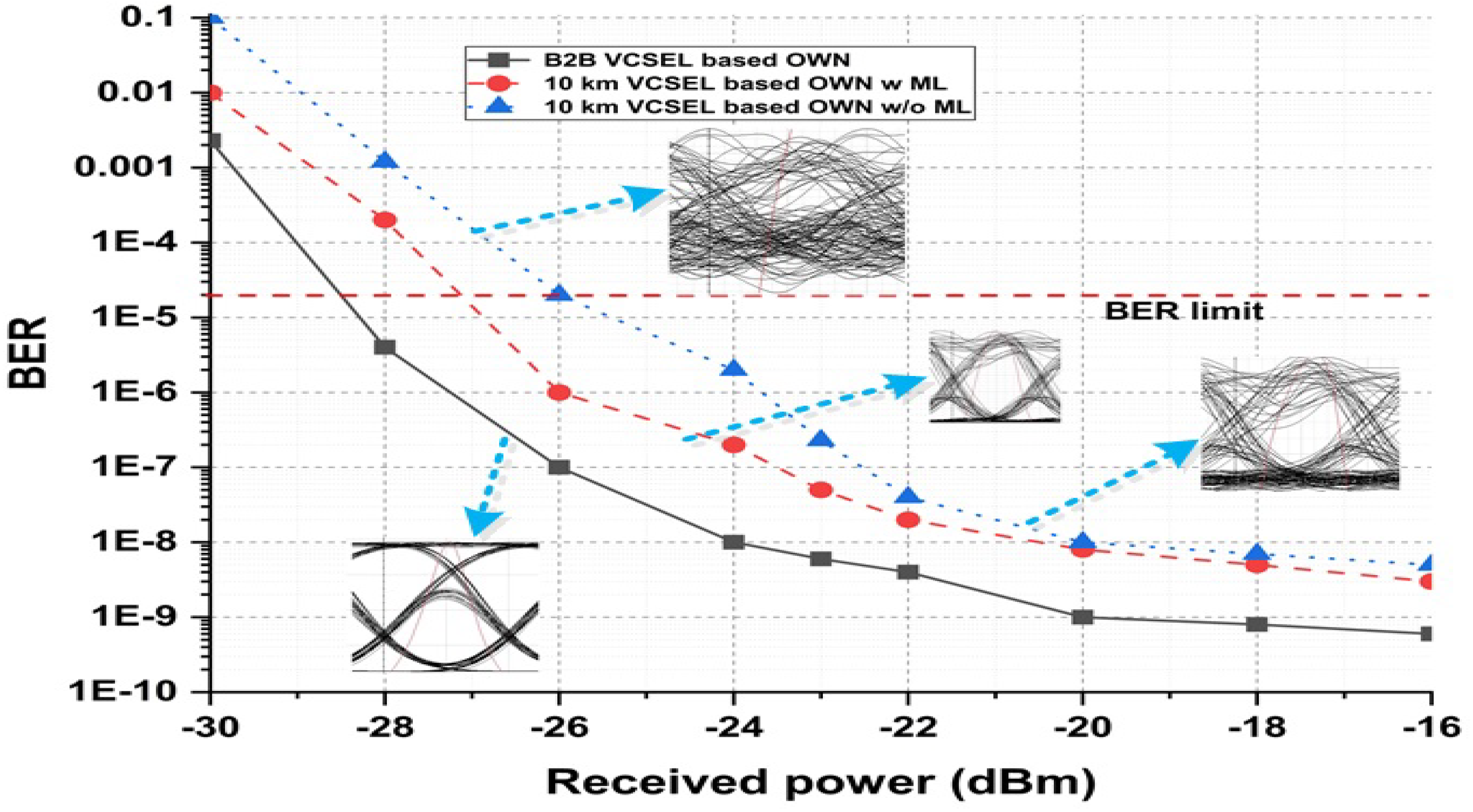
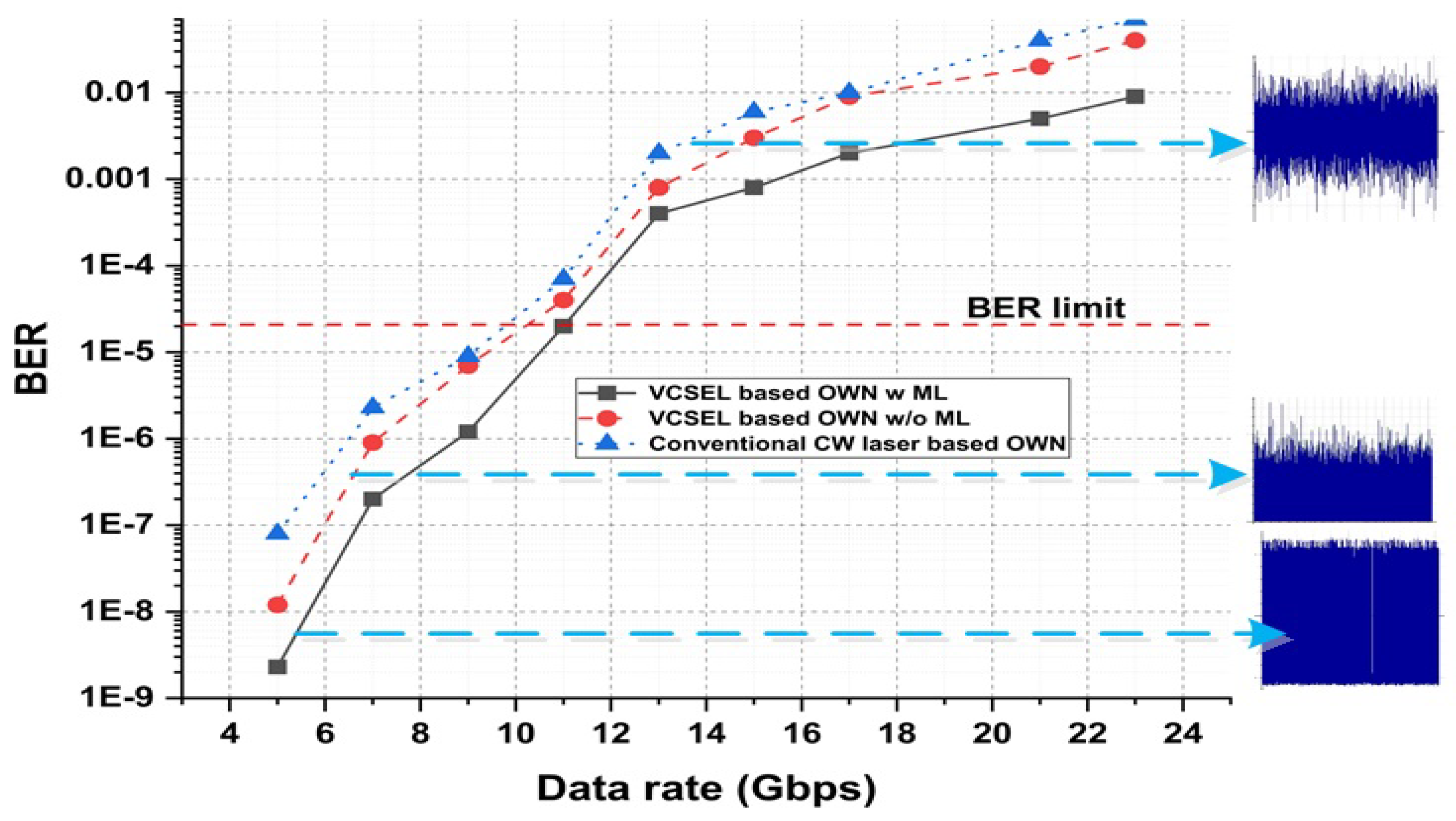
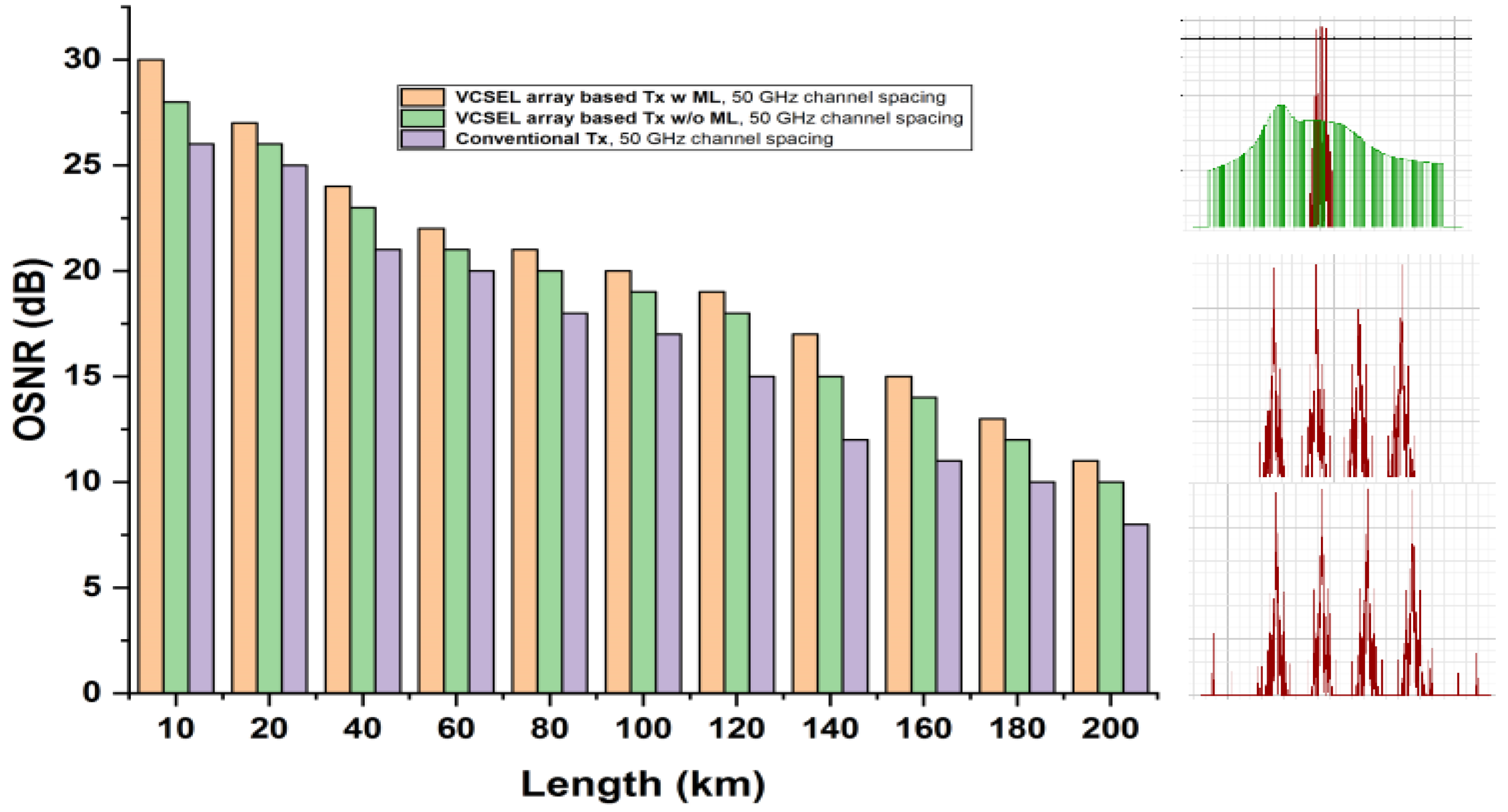



| Parameter | Units |
|---|---|
| IFFT size | 256 |
| Length of training sequence | 2 |
| Fiber length | 10 to 100 km |
| QAM order | 4 |
| cycle prefix | 1/32 |
| VCSEL wavelength | 850 to 1300 nm |
| Responsivity | 0.4 A/W |
| Area of photodetector | 20 mm2 |
| Current spectral density | 4 pA |
| Bias current | 9 mA |
Publisher’s Note: MDPI stays neutral with regard to jurisdictional claims in published maps and institutional affiliations. |
© 2022 by the authors. Licensee MDPI, Basel, Switzerland. This article is an open access article distributed under the terms and conditions of the Creative Commons Attribution (CC BY) license (https://creativecommons.org/licenses/by/4.0/).
Share and Cite
Armghan, A.; Aliqab, K.; Ali, F.; Alenezi, F.; Alsharari, M. Vertical Cavity Surface Emitting Laser Performance Maturing through Machine Learning for High-Yield Optical Wireless Network. Micromachines 2022, 13, 2132. https://doi.org/10.3390/mi13122132
Armghan A, Aliqab K, Ali F, Alenezi F, Alsharari M. Vertical Cavity Surface Emitting Laser Performance Maturing through Machine Learning for High-Yield Optical Wireless Network. Micromachines. 2022; 13(12):2132. https://doi.org/10.3390/mi13122132
Chicago/Turabian StyleArmghan, Ammar, Khaled Aliqab, Farman Ali, Fayadh Alenezi, and Meshari Alsharari. 2022. "Vertical Cavity Surface Emitting Laser Performance Maturing through Machine Learning for High-Yield Optical Wireless Network" Micromachines 13, no. 12: 2132. https://doi.org/10.3390/mi13122132
APA StyleArmghan, A., Aliqab, K., Ali, F., Alenezi, F., & Alsharari, M. (2022). Vertical Cavity Surface Emitting Laser Performance Maturing through Machine Learning for High-Yield Optical Wireless Network. Micromachines, 13(12), 2132. https://doi.org/10.3390/mi13122132






